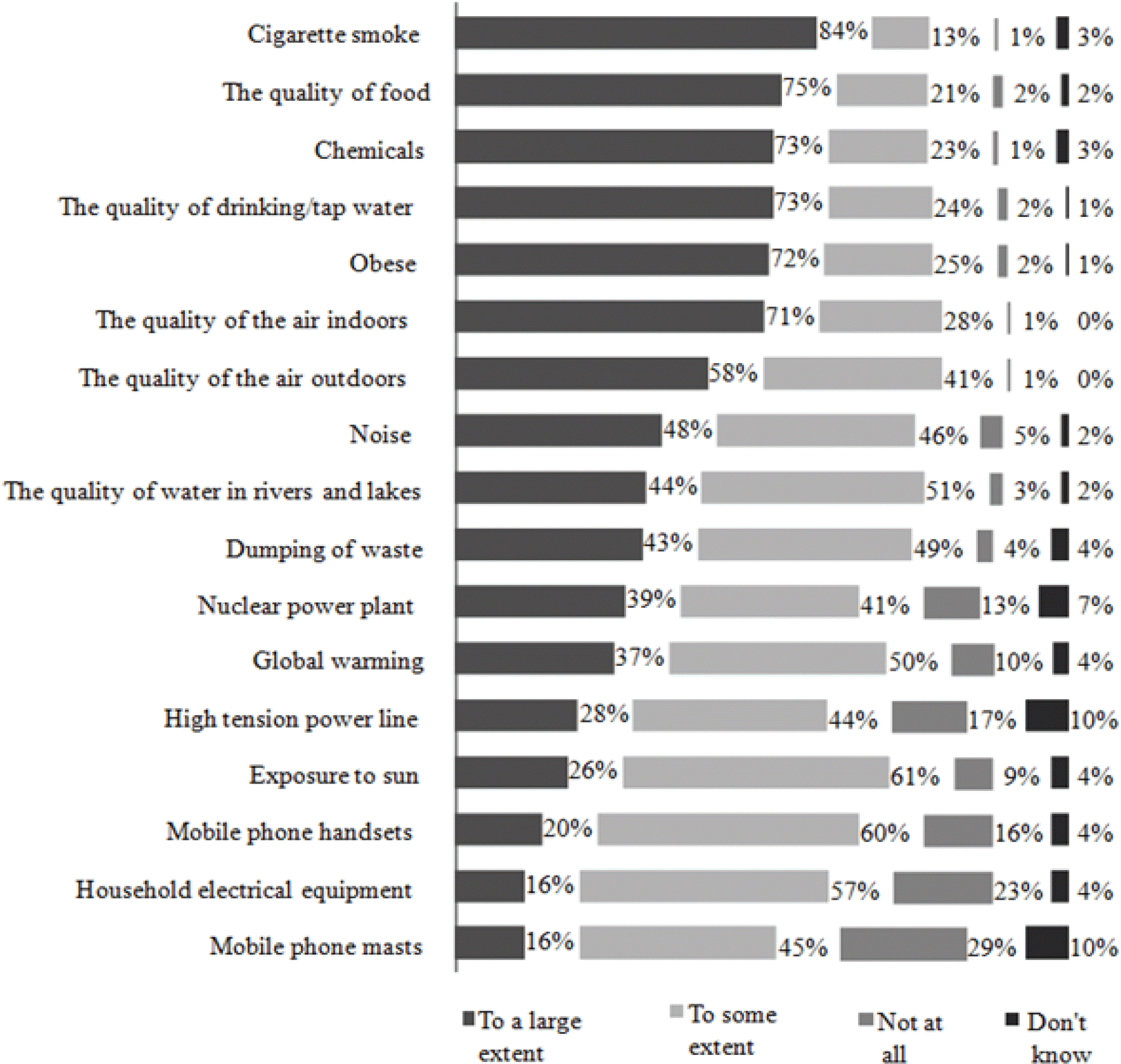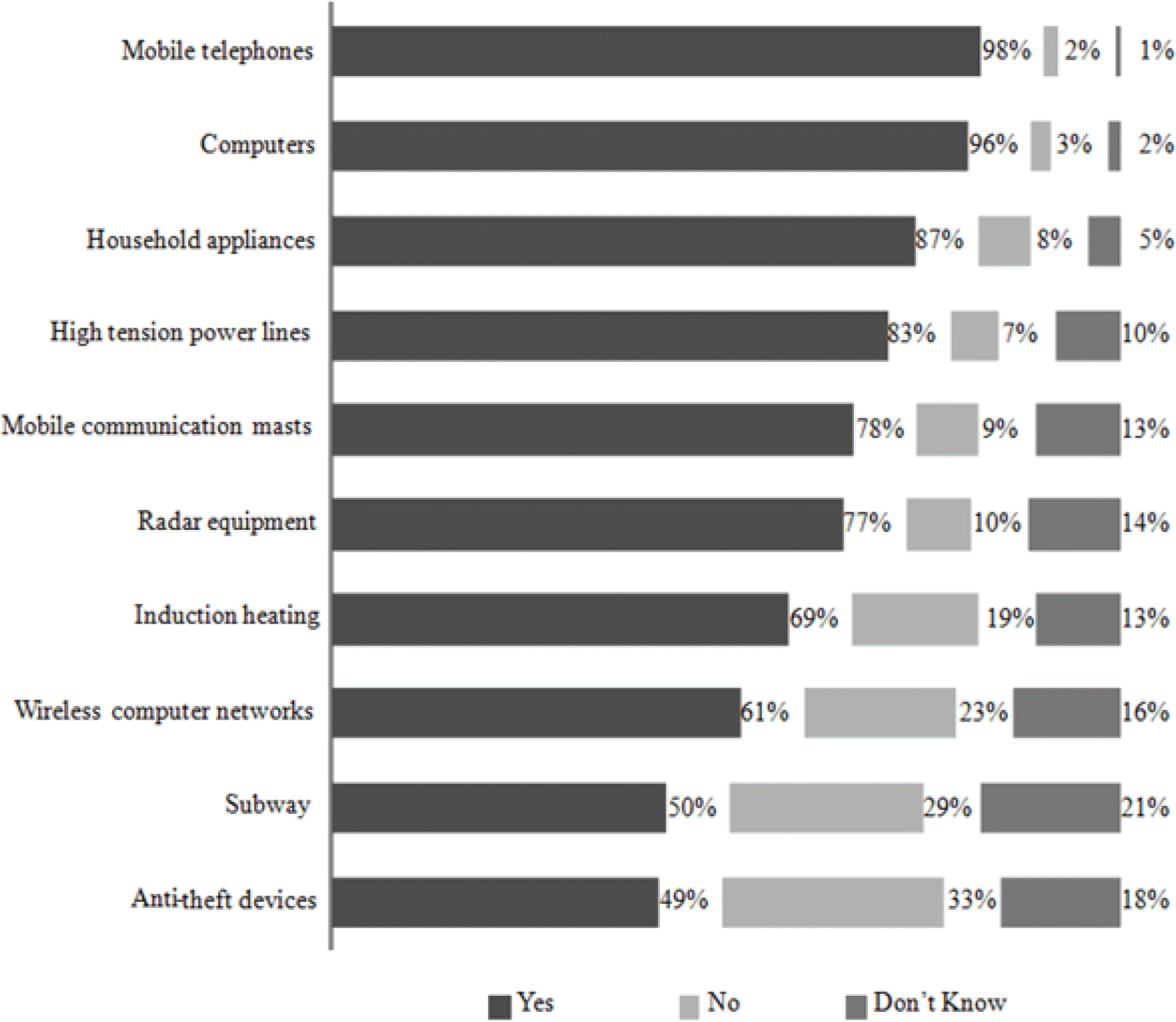Abstract
Background
This study assessed the perceptions of healthcare staff of the health risks of exposure to electromagnetic fields (EMF).
Methods
In total, 328 healthcare workers (e.g., physicians, nurses, medical students, and paramedics) completed a self-administered questionnaire. The questionnaire assessed the following: risk perceptions of 17 environmental factors as potential health threats; EMF sources; information for the potential risks of EMF; and thoughts on how to protect the public from potential EMF-related health risks.
Results
Of the included environmental factors, high-tension power lines and mobile phone handsets were ranked as the second and fourth lowest perceived risk, respectively. Approximately 60% of respondents were concerned about the potential health risks of EMF and dissatisfied with the information they received. The main reason for dissatisfaction was insufficient information. The most frequently cited action was that the government should review the available scientific evidence on potential EMF-related health risks.
REFERENCES
1.Chung EK., Kim KB., Chung KJ., Lee IS., You KH., Park JS. Occupational exposure of semiconductor workers to ELF magnetic fields. J Korean Soc Occup Environ Hyg. 2012. 22(1):42–51.
2.Jeon IS. Management strategies for electromagnetic fields in electric power lines. J Kor Electromagn Eng Soc. 2003. 14(10):1017–23.
3.World Health Organization. Electromagnetic fields and public health: Exposure to extremely low frequency fields, Fact Sheet No. 322. Geneva: World Health Organization;2007. [Accessed Jan 5, 2015].http://www.who.int/peh-emf/publications/facts/fs322/en.
4.IARC (International Agency for Research on Cancer) Working Group on the Evaluation of Carcinogenic Risks to Humans. Non-ionizing radiation, Part 1: Static and extremely low-frequency (ELF) electric and magnetic fields. Lyon, France: IARC Press;2002.
5.Kwon BC. The daily record of Miryang power-transmission tower event. Changwon: Kyungnam Domin Daily News;2013. [Accessed Jan 5, 2015].http://www.idomin.com/news/article-View.html?idxno=427239.
6.Hong YS. No more transmission towers on the sky of Dangjin. Cheongju: Dongyang Daily news;2014. [Accessed Jan 5, 2015].http://www.dynews.co.kr/news/articleView.html?idxno=227219.
7.You MS. The study of health-risk perception: Implications for health services research. Korean journal of health policy and administration. 2009. 19(3):45–70.

8.Cho YS., Kim YS., Jeon HJ., Kim DK., Lee CM., Hong SC, et al. A case study for application on extremely low frequency-electric and magnetic fields (ELF-EMFs) risk communication program in Korea. J Korean Soc Indoor Environ. 2012. 9(1):45–52.
9.TNS Opinion & Social. Electromagnetic Fields Report. Special Eurobarometer 347, Wave 73.3. Brussels: European Commission;.
10.Tseng MC., Lin YP., Hu FC., Cheng TJ. Risks perception of electromagnetic fields in Taiwan: the influence of psychopathology and the degree of sensitivity to electromagnetic fields. Risk Anal. 2013. 33(11):2002–2012.

11.Min SW. Report of public relations business of electromagnetic fields in 2013. Seoul: The Korean Institute of Electrical Engineers;2014.
12.Korea Communications Agency. A survey on awareness of health-risk of electromagnetic fields of living environment. Naju: KCA Trends & Perspectives;2013.
13.Ahn YO. Evaluation of safety of extremely low frequency electromagnetic field and development of practical reduction technique (case-control study about childhoold cancer below 16 years). Goyang: Korea Institute of Energy technology and Evaluation and Planning;2008.
14.Ahn YO. The ecological study on cancer prevalence aspect of surrounding area of 154/345kV power-transmission lines. Go-yang: Korea Institute of Energy technology and Evaluation and Planning;2013.
15.Kim JS., Shin AS., Kim SS., Jung GC., Kim MG., Jung SH. Development of IARC (International Agency for Research on Cancer) monographs in Korean version. National Cancer Center. 2012.
16.Jang SK., Lee SJ., Yoo SW., Cho YS., Lim HS., Lim JH, et al. A survey of the EMF levels in Korea (Ⅱ), EMF levels of subway and electric appliances: Indoor environmental research board, air quality research department. Incheon: National Institute of Environmental Research;2004.
17.Kim HI., Lee EK. Analysis of media reports on the safety of herbal medicines from the viewpoint of risk communication. J Health Tech Assess. 2014. 2(2):99–104. 2010.
Table 1.
Socio-demographic characteristics of respondents
Table 2.
Concerns and information on potential health risk of electromagnetic fields
Table 3.
Appropriate organization and roles of the government to protect publics from potential health risks related to electromagnetic fields




 PDF
PDF ePub
ePub Citation
Citation Print
Print




 XML Download
XML Download